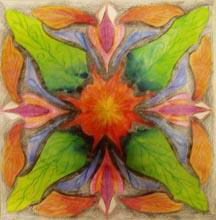Goal (Terminal Objective):
Students will learn the principle of design formal (symmetrical) balance and apply creative problem solving to complete an original symmetrical motif/design.
Objective:
Students will demonstrate their visual understanding of formal balance by creating a symmetrical design, which also exhibits their knowledge of color theory upon completion of the composition.
National Standards:
Visual Arts Grades 9-12 Content Standard 1: Understanding and applying media techniques, and processes
Visual Arts Grades 9-12 Content Standard 3: Choosing and evaluating a range of subject matter, symbols, and ideas
Visual Arts Grades 9-12 Content Standard 5: : Reflecting upon and assessing the characteristics and merits of their work and the work of others.
Purpose:
Students will aesthetically scan examples of works of art displaying formal balance. Students will apply their knowledge and create an original symmetrical design. Students will understand and apply the use of tracing paper to layout a symmetrical drawing. Students will visually demonstrate knowledge of color theory in their original choices of creative color to complete the composition.
New Vocabulary:
formal balance, symmetry, motif
Materials:
White drawing paper cut into a square, Tracing paper, Pencil, and the following Sargent Art supplies:

#22-8426 16 ct. Art-Time Premium Oval Watercolor Set
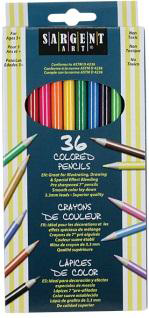
#22-7236 36ct.Colored Pencils
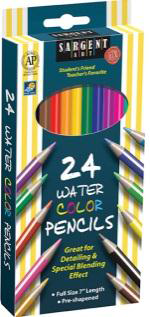
#22-7205 24 ct. Watercolor Pencils

#56-6000 5 ct. Mixed Hair Brush Assortment

#22-7244 144 ct. Graphite Pencils
Time:
approximately 4-5 class periods
Introduction and Motivation (Set):
Discuss with students what they picture in their heads when the term design is used. What qualities of a work of art help it to be classified as a design or motif, rather than another type of composition (i.e. landscape, portrait, etc.)? Show examples of symmetry. Talk about what is symmetrical from nature. Have students complete a freehand symmetry worksheet (see link in references ). Practice a simple side-to-side symmetrical design using tracing paper so they can see how it works.
Instruction:
- Begin by folding a square piece of paper into eighths. For younger students, this number could be lessened and, for advanced students, this number could beincreased. The more divisions in your square, the more complex of a final design you’llhave.
- In just one section of the folded paper, draw some simple lines andshapes.
- Using tracing paper, trace this first section. Begin transferring the lines and shapesinto each of the other seven sections by flipping it around the square. Match up the lines to achieve symmetrical shapes. It s always an exciting surprise to see how the composition develops into a completed motif.
- Students begin by applying color washes to shapes using Sargent Art watercolors. When the watercolors are dry, use colored pencils to add detail and shadowing within the shapes.
paper folded into eighths
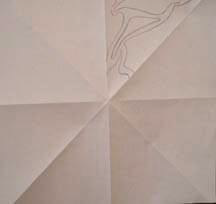
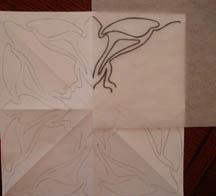
tracingpaper transfer
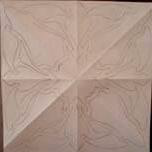
completed motif inpencil
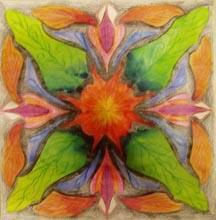
completed symmetrical motif
Activities:
(1) Guided Practice:
a. Students aesthetically scan examples of pictures representing formalbalance. (example: M.C.Escher see resources)
b. Students discuss things in nature and manmade objects thatdemonstrate symmetricalbalance.
c. Students use tracing paper to transfer a small section of free hand lines and shapes to fill a composition visually demonstratingsymmetry.
d. Students demonstrate their technical ability to blend colors to achieve aneye- catching original creative design.
e. Students demonstrate individual creativity by adding detail with coloredpencil. Often times, a design can take on a very objective character by the details added. The example is titled Fire, Water, Life because the organic shapes that evolved remind one of those earthlyelements.
(2) Independent Practice and Check forUnderstanding:
a. Teacher circulates and helps students with design questions. Suggest to students to stay away from very small shapes or a lot of detail in their initial drawings. It will get complex when repeated eighttimes.
b. Teacher offers individual help with color blending and suggestions of colored pencil details that can be added after the watercolor paint isdry.
(3) Closure:
a. These designs look awesome when displayed collectively. The colors are bright and will fill the room or hallway withlife!
b. Teacher leads students in a discussion of what each student s design may remind others of according to the detail and title added by the individualstudent.
Evaluation:
Level One — The finished design very successfully demonstrates the student s understanding of formal (symmetrical) balance. The student has shown strong technical skills in their use of color blending and color schemes. The student has shown a high level of creativity in completing the motif with original detail. Craftsmanship is outstanding.
Level Two — The finished design demonstrates the student s understanding of formal (symmetrical) balance. The student has shown good technical skills in his/her use of color blending and color schemes. The student has shown creativity in completing the motif with original detail. Craftsmanship is good.
Level Three — The finished design demonstrates effort on the student s part to show his/her understanding of formal (symmetrical) balance. The student has shown little technical skill in his/her use of color blending and color schemes. The student has shown limited creativity in completing the motif with any detail. Craftsmanship is minimal.
Level Four — The finished design lacks evidence of the student s understanding of formal (symmetrical) balance. There is no color blending or visual knowledge of color schemes present. The student s final project lacks creativity and craftsmanship.
Extension:
This project can be greatly simplified for younger students, or vice versa for older, more advanced students. It also fits in very well within a unit of color theory.Tempera or acrylic paints could be used for a different visual effect.
Resources:
http://www.skillsforlearning.net/cd1-35.htm
http://www.partow.net/miscellaneous/symmetry.html
http://www.mcescher.com/Gallery/symmetry-bmp/E69.jpg
http://www.emblibrary.com/EL/product_images/a3940r.jpg



